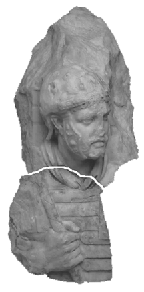The University Record, October 15, 1996
Getting it all back together again
 This Roman soldier lost his head nearly a century ago. Finally reunited, the entire piece is on display at the Kelsey.
This Roman soldier lost his head nearly a century ago. Finally reunited, the entire piece is on display at the Kelsey.
His head was housed in a museum in Rome—his torso at the University of Michigan in Ann Arbor. For nearly a century the Roman soldier remained separated. Now, with his head and torso reunited, the marble soldier will appear with other fragments of Roman relief sculpture at Kelsey Museum of Archaeology in a landmark exhibition, “Images of Empire: Flavian Fragments in Rome and Ann Arbor Rejoined,” continuing through February 17, 1997.
When marble fragments came to light during an urban development project in the Piazza della Repubblica in Rome, Paul Hartwig, a German scholar, and Francis W. Kelsey, a U-M professor, acquired the sculptures on the art market. Hartwig purchased and donated nine pieces to the Museo Nazionale Romano in Rome. Kelsey bought six fragments for the U-M collections. Each was apparently unaware of the other’s acquisitions.
It was 1978 before someone realized that the head of a Roman soldier in Rome joined perfectly with the torso of a Roman soldier in Ann Arbor. Thus, all 15 pieces, now designated the “Hartwig-Kelsey fragments,” actually belonged to a single complex, probably the Templum Gentis Flaviae, The Temple of the Flavian Dynasty, at its height of glory sometime between AD69 and AD96.
“Images of Empire” is a reconstruction of the of the Templum Gentis Flaviae with a facade enlivened by male caryatids (anthropomorphic architectural supports) who stand in front of palm trees, symbols of the province of Judaea where the Flavian emperors conquered rebellious Jerusalem and gained a glorious Roman triumph. Panels of relief sculpture depict two scenes drawn from Roman state religion and imperial ceremony.
The reconstruction consists of casts of all the sculptures and uses a new mold-making technique, each step of which is documented in the exhibition. Without damage to the marble surfaces of the artifacts, the process produced casts of such quality that they merit display alongside the original sculptures.

